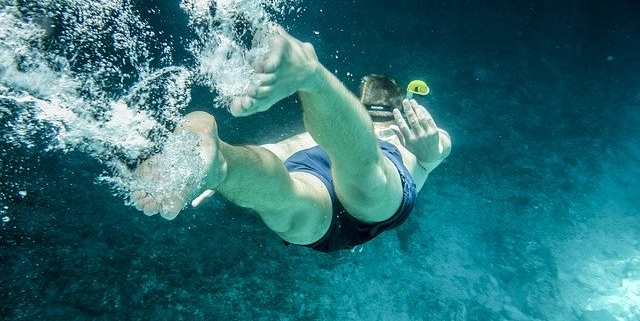Snorkeling is an easy and fun way to explore aquatic environments. You don’t need expensive equipment to snorkel, nor do you need any special training or certification. As a result, snorkeling has become a popular recreational activity. If you’re planning to snorkel, though, you should follow these 10 important dos and don’ts.
#1) Do Practice First
Always practice — either in a shallow area of water near the shore or in a swimming pool — before going to your intended snorkeling destination. Practicing gives you the opportunity to familiarize yourself with your gear and how it works. You don’t have to spend an entire hour practicing. Rather, a short 10- to 20- minute practice session should suffice, at which point you’ll be ready to tackle more complex snorkeling environments.
#2) Don’t Tilt Your Head
A common mistake beginners make when snorkeling is tilting their head. When you’re floating facedown and tilt your head, the snorkel may breach the water’s surface. Tilting your head either forward or backward may cause this to occur. And once the snorkel enters the water, you will no longer have a source of fresh air. Instead, inhaling will suck water into your mouth. You can prevent this from happening by keeping your head straight and horizontally aligned with the rest of your body.
#3) Do Wear a High-Quality Mask
It’s important to wear a high-quality diving mask when snorkeling. Low-quality diving masks often fail to create a waterproof seal when worn. As a result, they are more likely to flood with water than their high-quality counterparts. If you’re serious about snorkeling, invest in a high-quality diving mask. You can use it for both snorkeling and diving, making it well worth the cost.
Here are some tips on how to choose a high-quality diving mask:
- Check to see what material it’s made of.
- Inspect the seal around the perimeter to ensure it’s durable.
- Make sure it features an adjustable strap.
- Stick with a reputable brand.
#4) Don’t Breath Too Rapidly
What’s wrong with breathing rapidly? Well, the faster you inhale and exhale, the more energy you’ll consume. As a result, breathing rapidly may leave you feeling fatigued and exhausted. The correct way to breathe when snorkeling is to inhale and exhale at a normal rate. You should try to get into the habit of breathing while snorkeling just like you normally breathe when on land. If you inhale and exhale rapidly, you’ll consume an excessive amount of energy, resulting in fatigue and exhaustion. It takes a little practice, but learning to control your breathing is essential for snorkeling because it allows you to conserve your body’s energy.
#5) Do Wear Fins
In addition to a high-quality diving mask, you should also wear fins when snorkeling. Fins allow you to swim more effectively and efficiently by increasing the surface area of your feet. Not surprisingly, the human foot isn’t designed for swimming. You can still swim without fins, but the small surface area of your feet means you’ll have to consume a substantial amount of energy to generate a minimal amount of propulsion. Fins solve this problem by expanding the surface area of your feet. When you kick while wearing a pair of fins, the large surface area will create greater propulsion. As a result, you can snorkel over larger areas if you wear fins.
#6) Don’t Inhale When Diving
You can dive while snorkeling, but you need to hold your breath when both descending and ascending. Otherwise, you’ll suck water into your mouth. If you see an object on the bottom of the seabed or lakebed and want to inspect it up and close, take a deep breath immediately before submerging. If you happen to inhale when diving, you’ll inadvertently suck water into your mouth — and that’s something no one wants to experience during a snorkeling trip.
#7) Do Snorkel With a Buddy
Like with diving, it’s best to snorkel with at least one other person. Snorkeling alone carries an inherent risk of injury. If you get tangled in debris or experience a medical emergency, no one will be able to help you. Besides, most people will agree that it’s more enjoyable to snorkel with a buddy rather than alone. For these reasons, you should try to find at least one other person with whom to snorkel. You’ll experience a safer and more enjoyable snorkeling trip by pairing up with a buddy.
#8) Don’t Forget Sunscreen Lotion
Because of the way in which your body is horizontally positioned, snorkeling may lead to sunburn if you forget to wear sunscreen lotion. Before getting in the water, apply a high-SPF sunscreen lotion to every inch of exposed skin. The sunscreen lotion will create a barrier between your skin and sun’s ultraviolet (UV) rays, thereby protecting you from potentially painful sunburn.
Keep in mind that not all sunscreen lotion is waterproof. If you use a traditional non-waterproof sunscreen lotion, it will likely wash off your skin once you get in the water. For maximum protection against sunburn while snorkeling, choose a waterproof sunscreen lotion with a high SPF. Of course, SPF refers to “Sun Protection Value.” Generally speaking, high-SPF sunscreen lotions reflect more of the sun’s UV rays than low-SPF sunscreen lotions.
#9) Do Exhale Forcefully When Water Enters Your Snorkel
If water happens to enter your snorkel, you should exhale forcefully through your mouth to clear it. Diving, for example, will inevitably flood your snorkel with water. Even if you don’t inhale, water will still enter your snorkel. You can clear your snorkel, however, by forcefully exhaling through your mouth. Upon returning to the surface, blow through your mouth to expel the water. You should do this at least two times to ensure that no water is remaining in your snorkel. Assuming your snorkel is dry, you can then breathe normally again without fear of sucking water into your mouth.
You won’t always have to clear your snorkel. If you stay on the surface at all time with your head horizontally aligned, water shouldn’t enter your snorkel. Anytime you dive or otherwise submerge your snorkel, though, it will flood will water. Flooding is an all-too-common scenario encountered by people who dive while snorkeling. You can clear your snorkel, however, simply by exhaling through your mouth with enough force to push the water out the top.
#10) Don’t Spend Too Much Time Snorkeling
It’s easy to lose track of the time when snorkeling. You may begin early the morning, and before you know it, the sun is already setting. While spending long hours in the water may sound harmless, it’s best to limit your snorkeling trips to a reasonable length of time. Many people, for instance, become dehydrated when snorkeling. You won’t be able to drink water when you’re floating facedown in a lake or the ocean. But because you are surrounded by water, you won’t necessarily know if and when you become dehydrated. If you’re planning to snorkel for multiple hours, remember to get out of the water every half-hour or so to rest and drink water.
Snorkeling is a fun and rewarding hobby that requires nothing more than a diving mask, a snorkel and a pair of fins. Regardless of where you’re planning to snorkel, though, you should follow these 10 dos and don’ts.
Want to create your own custom dive logs? Contact us today to learn more about our custom dive logs.



